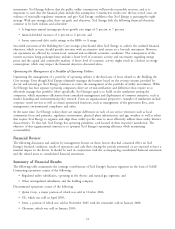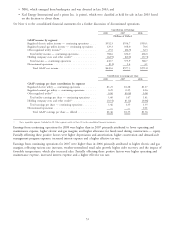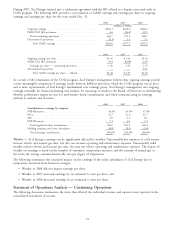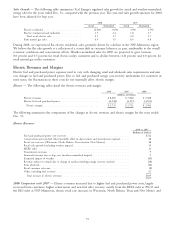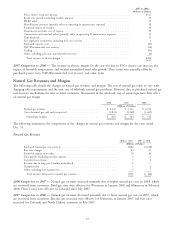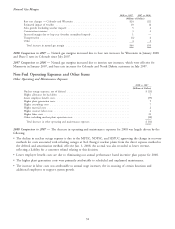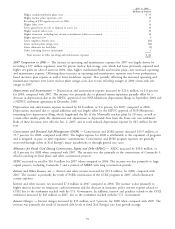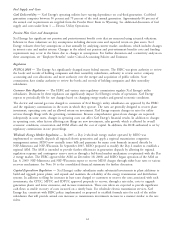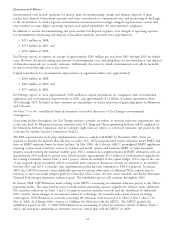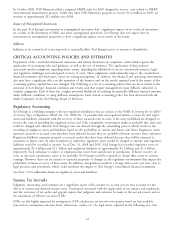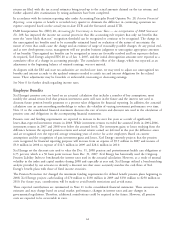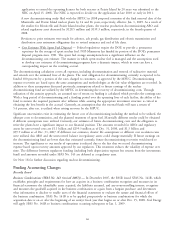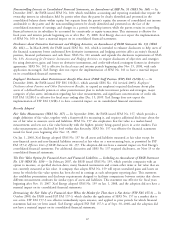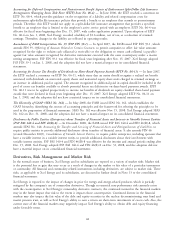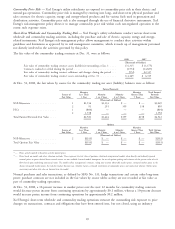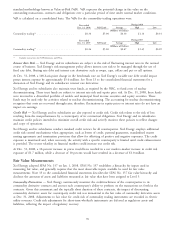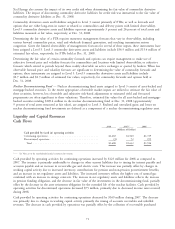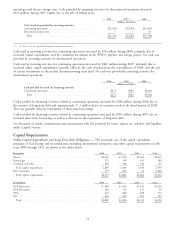Xcel Energy 2008 Annual Report Download - page 72
Download and view the complete annual report
Please find page 72 of the 2008 Xcel Energy annual report below. You can navigate through the pages in the report by either clicking on the pages listed below, or by using the keyword search tool below to find specific information within the annual report.Environmental Matters
Environmental costs include payments for nuclear plant decommissioning, storage and ultimate disposal of spent
nuclear fuel, disposal of hazardous materials and waste, remediation of contaminated sites and monitoring of discharges
to the environment. A trend of greater environmental awareness and increasingly stringent regulation has caused, and
may continue to cause, higher operating expenses and capital expenditures for environmental compliance.
In addition to nuclear decommissioning and spent nuclear fuel disposal expenses, costs charged to operating expenses
for environmental monitoring and disposal of hazardous materials and waste were approximately:
• $213 million in 2008;
• $173 million in 2007; and
• $152 million in 2006.
Xcel Energy expects to expense an average of approximately $245 million per year from 2009 through 2013 for similar
costs. However, the precise timing and amount of environmental costs, including those for site remediation and disposal
of hazardous materials, are currently unknown. Additionally, the extent to which environmental costs will be included
in and recovered through rates is not certain.
Capital expenditures for environmental improvements at regulated facilities were approximately:
• $230 million in 2008;
• $439 million in 2007; and
• $571 million in 2006.
Xcel Energy expects to incur approximately $230 million in capital expenditures for compliance with environmental
regulations and environmental improvements in 2009, and approximately $1.4 billion of related expenditures from
2010 through 2013. Included in these amounts are expenditures to reduce emissions of generating plants in Minnesota
and Colorado.
See Note 17 to the consolidated financial statements for further discussion of Xcel Energy’s environmental
contingencies.
Generating facilities throughout the Xcel Energy territory currently are subject to mercury reduction requirements only
at the state level. In Minnesota mercury emissions from A.S. King and Sherco generating facilities will be regulated by
the Minnesota Mercury Legislation, and in Colorado, eight units are subject to a mercury emissions rule passed by the
Colorado Air Quality Control Commission (AQCC).
The EPA required states to develop implementation plans to comply with BART by December 2007. States are
required to identify the facilities that will have to reduce SO2, NOx and particulate matter emissions under BART and
then set BART emissions limits for those facilities. In May 2006, the Colorado AQCC promulgated BART regulations
requiring certain major stationary sources to evaluate and install, operate and maintain BART to make reasonable
progress toward meeting the national visibility goal. PSCo estimates that implementation of BART alternatives will cost
approximately $254 million in capital costs, which includes approximately $113 million in environmental upgrades for
the existing Comanche Station Units 1 and 2 project, which are included in the capital budget. PSCo expects the cost
of any required capital investment will be recoverable from customers. Emissions controls are expected to be installed
between 2011 and 2014. Colorado’s state implementation plan has been submitted to EPA for approval. In January
2009, the CAPCD initiated a joint stakeholder process to evaluate what types of additional NOx controls may be
necessary to meet reasonable progress goals for Colorado’s Class I areas, the new ozone standard, and Rocky Mountain
National Park nitrogen deposition reduction goals. The stakeholder process will continue throughout 2009.
In January 2008, NSP-Minnesota made a filing to the MPUC concerning an emissions reduction project at the Sherco
generating facility. The improvement project would include generating capacity upgrades for all three units; additional
SO2 emission reductions on Units 1 and 2 to improve mercury emission controls; and the installation of additional
NOx controls. Given changes in circumstance related to technology, the economy and a lower forecast of energy
consumption, NSP-Minnesota is currently reassessing the emissions reduction project at Sherco Units 1 and 2. On
Nov. 6, 2008, Xcel Energy filed a request to withdraw the filed plan with the MPUC. The MPUC granted the
withdrawal request on Dec. 9, 2008. NSP-Minnesota is reexamining its plans for emission controls at Sherco Units 1
and 2 and anticipates submitting an alternative mercury control plan with the MPUC in 2009.
62


